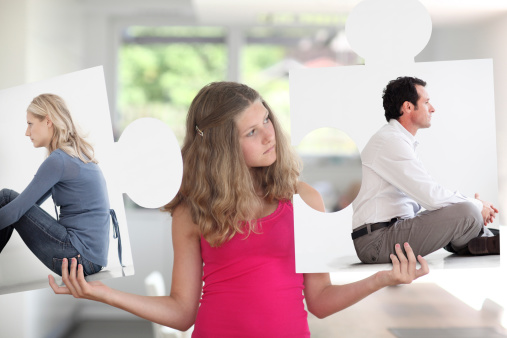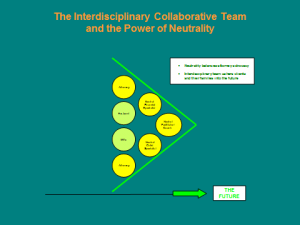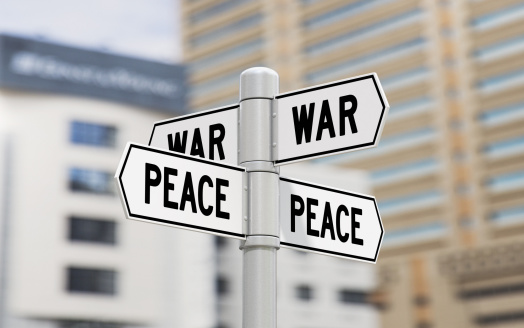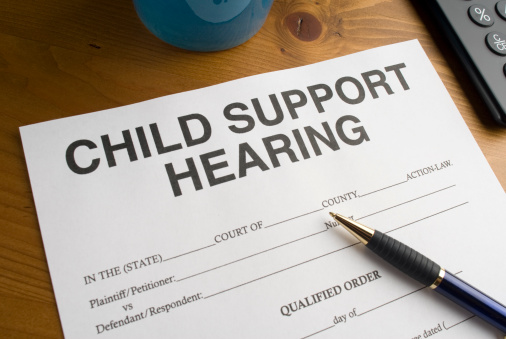 The secret to a constructive and respectful divorce is to start at the end and work backward. Ask yourself, “What do I want my life, my spouse’s life, and my children’s lives to look like when the divorce is all over? What is my vision for the future?”
The secret to a constructive and respectful divorce is to start at the end and work backward. Ask yourself, “What do I want my life, my spouse’s life, and my children’s lives to look like when the divorce is all over? What is my vision for the future?”
- Children/Family We want our children and ourselves to feel that we are a family that loves and cares for each other.
- Relational We want us to look back on this difficult time and be proud of how we handled ourselves and each other. We want both of us to be happy in the future.
- Financial We want our final agreement to ensure equitable life styles and standards of living. We want our final agreement to provide financial security for both of us in retirement and in the event of the death of either of us. We want our final agreement to respect the financial decisions/intent of our respective families to leave us money.
- Process We want a divorce process that supports a positive future. We want a divorce process in which we both feel heard and safe to discuss difficult issues. We want to be comfortable with our final agreement and to have a mechanism for implementing it. We want our divorce process to be cost effective and efficient. We want to minimize the emotional and financial stress of our divorce.
- Children For our son to have a solid, cohesive parenting team who loves him. For our son to be shielded from the negative aspects of the divorce.
- Financial For both households to have financial stability and security. For us to be debt-free by using an intentionally controlled plan of action.
- Relational/Emotional That we create a trusting relationship with each other and the potential for friendship. That we reduce the emotional and financial stress we feel as a result of our divorce.
- Process That the collaborative process be as cost-effective as possible while obtaining the added value that our neutral professionals bring to the process.
- For our children not to feel divided.
- For our children to feel comfortable with both of us.
- For us to convey a sense of harmony to our children.
- To have financial security for both of us.
- To get along with each other after the divorce; to have mutual respect for each other; and to have a pleasant relationship.


 Divorce is a crisis in the life of a family. It is not actually a legal crisis, though it requires this expertise to ensure that legal resolutions are reached regarding financial matters. It is not a theoretical crisis. It is a genuine emotional crisis. What does this mean for children?
Some years after I began my therapy practice with children and families decades ago, a researcher named Judith Wallerstein published the results of her longitudinal study on the negative impact of divorce on children. The data were a wake-up call, shocking to some, sobering to all. Mental health experts responded by saying parents and social institutions needed to be more attentive to the impact of divorce on children. A book was written advocating bird nesting—parents rather than children transitioning to and from the homestead—as an alternative “custody” arrangement for families (an option we now know to be a temporary rather than permanent solution). Questions began to be raised on the impact of parenting time arrangements that essentially minimized otherwise healthy and loving relationships between parents and children.
At the time Wallerstein’s study was published, the options available for divorcing parents were largely adversarial in nature. The focus was “rights based,” not based on supporting co-parenting and keeping children out of the middle of the crisis. Many of the parents with whom I work attest to the emotional trauma they experienced when their own parents divorced. In fact, it is likely these divorcing parents were assured by their attorneys that “children are resilient—your kids will be fine.” But we know that children do not become resilient in a vacuum. They need adults to create environments of support and attention to their needs.
Collaborative team divorce offers a clear and powerful alternative for parents who love their children and want to envision a hopeful future for them. Families work with a multidisciplinary team of professionals with specific skills and experience. Mental health expertise is woven throughout the process, both to specifically support children and to provide parents with the best possible grounding for effective co-parenting. If you want to know more about how your family can weather the emotional crisis of divorce with the most dignity and respect for the needs of your children, please learn more about Collaborative team practice at this link to the website for the
Divorce is a crisis in the life of a family. It is not actually a legal crisis, though it requires this expertise to ensure that legal resolutions are reached regarding financial matters. It is not a theoretical crisis. It is a genuine emotional crisis. What does this mean for children?
Some years after I began my therapy practice with children and families decades ago, a researcher named Judith Wallerstein published the results of her longitudinal study on the negative impact of divorce on children. The data were a wake-up call, shocking to some, sobering to all. Mental health experts responded by saying parents and social institutions needed to be more attentive to the impact of divorce on children. A book was written advocating bird nesting—parents rather than children transitioning to and from the homestead—as an alternative “custody” arrangement for families (an option we now know to be a temporary rather than permanent solution). Questions began to be raised on the impact of parenting time arrangements that essentially minimized otherwise healthy and loving relationships between parents and children.
At the time Wallerstein’s study was published, the options available for divorcing parents were largely adversarial in nature. The focus was “rights based,” not based on supporting co-parenting and keeping children out of the middle of the crisis. Many of the parents with whom I work attest to the emotional trauma they experienced when their own parents divorced. In fact, it is likely these divorcing parents were assured by their attorneys that “children are resilient—your kids will be fine.” But we know that children do not become resilient in a vacuum. They need adults to create environments of support and attention to their needs.
Collaborative team divorce offers a clear and powerful alternative for parents who love their children and want to envision a hopeful future for them. Families work with a multidisciplinary team of professionals with specific skills and experience. Mental health expertise is woven throughout the process, both to specifically support children and to provide parents with the best possible grounding for effective co-parenting. If you want to know more about how your family can weather the emotional crisis of divorce with the most dignity and respect for the needs of your children, please learn more about Collaborative team practice at this link to the website for the 







 Not all divorces are related to alcohol abuse, but the percentage is fairly high. I don’t have any scientific study, but my own experience of observing thousands of divorces over three decades, I have found that nearly half of all divorces involve, at minimum, allegations of some type of alcohol abuse. From observing the interactions in these cases, as well as working with professionals in these areas, here are the most important observations I have made:
If you think there is a problem, you are probably right.
If one party truly believes there is alcohol abuse in the marriage, there is a very high probability that they are right. Yes, it is true that divorce can lead to many false allegations, particularly if you are in an adversarial divorce. However, while divorcing couples often exaggerate most flaws of the other spouse, I have found that, largely because of co-dependency dynamics, many spouses actually under report alcohol abuse.
If your spouse thinks you have a problem, you certainly have a problem.
How can I be certain? Easy. First, as indicated above, if your spouse truly thinks you have a problem, there is a high probably they are right. Moreover, even if they are wrong, their belief that you have a problem is, by itself, a major problem. In either case, the solution often points to undergoing a thorough and honest alcohol assessment. If you can get at the truth, everyone wins.
A spouse stopping or cutting back alcohol use during the divorce proves little. Often the spouse believed to have an alcohol problem will either stop using alcohol or cut back on alcohol use as the threat of divorce draws near. While this may (or may not) be a welcome reprieve for the family, it generally means very little in terms of determining the existence of a problem. Indeed, most chemical dependency counselors see frequent failed attempts to stop or cut back as being one of the indicators of alcoholism. Moreover, for most alcoholics, stopping drinking does not necessarily end the alcoholic behavior.
Sometimes alcohol use during divorce can be “situational”.
Divorce usually does not come up suddenly, but rather creeps into homes over months or years. As it creeps closer, the sadness or fear can sometimes cause non-alcoholics to temporarily abuse alcohol during this difficult time. While temporary abuse of alcohol still has serious consequences the long-term impact can be quite different than addressing alcoholism.
If alcohol is an issue, you need a process in which honesty can be rewarded. Divorce processes differ. Traditional divorces that operate in the shadow of the courthouse can sometimes seem to punish honesty in the sense that the person suspected of alcohol abuse feels compelled to either deny or minimize the allegations for fear of losing time with their children. On the other hand, processes such as Collaborative Law or mediation, by operating outside of court, can provide a safe place where alcohol use can be addressed as a health issue and not as a piece of evidence. To learn more about these options go to
Not all divorces are related to alcohol abuse, but the percentage is fairly high. I don’t have any scientific study, but my own experience of observing thousands of divorces over three decades, I have found that nearly half of all divorces involve, at minimum, allegations of some type of alcohol abuse. From observing the interactions in these cases, as well as working with professionals in these areas, here are the most important observations I have made:
If you think there is a problem, you are probably right.
If one party truly believes there is alcohol abuse in the marriage, there is a very high probability that they are right. Yes, it is true that divorce can lead to many false allegations, particularly if you are in an adversarial divorce. However, while divorcing couples often exaggerate most flaws of the other spouse, I have found that, largely because of co-dependency dynamics, many spouses actually under report alcohol abuse.
If your spouse thinks you have a problem, you certainly have a problem.
How can I be certain? Easy. First, as indicated above, if your spouse truly thinks you have a problem, there is a high probably they are right. Moreover, even if they are wrong, their belief that you have a problem is, by itself, a major problem. In either case, the solution often points to undergoing a thorough and honest alcohol assessment. If you can get at the truth, everyone wins.
A spouse stopping or cutting back alcohol use during the divorce proves little. Often the spouse believed to have an alcohol problem will either stop using alcohol or cut back on alcohol use as the threat of divorce draws near. While this may (or may not) be a welcome reprieve for the family, it generally means very little in terms of determining the existence of a problem. Indeed, most chemical dependency counselors see frequent failed attempts to stop or cut back as being one of the indicators of alcoholism. Moreover, for most alcoholics, stopping drinking does not necessarily end the alcoholic behavior.
Sometimes alcohol use during divorce can be “situational”.
Divorce usually does not come up suddenly, but rather creeps into homes over months or years. As it creeps closer, the sadness or fear can sometimes cause non-alcoholics to temporarily abuse alcohol during this difficult time. While temporary abuse of alcohol still has serious consequences the long-term impact can be quite different than addressing alcoholism.
If alcohol is an issue, you need a process in which honesty can be rewarded. Divorce processes differ. Traditional divorces that operate in the shadow of the courthouse can sometimes seem to punish honesty in the sense that the person suspected of alcohol abuse feels compelled to either deny or minimize the allegations for fear of losing time with their children. On the other hand, processes such as Collaborative Law or mediation, by operating outside of court, can provide a safe place where alcohol use can be addressed as a health issue and not as a piece of evidence. To learn more about these options go to